Examining Teen Health and Weight in America

When children are very young, parents may delight in their chubby cheeks and fleshy thighs. And while you can’t help but “ooh” and “ahh” over an adorable pudgy baby, there comes a time in almost everyone’s life where they must confront the question of weight and gauging how healthy they and their children actually are, which in America, may not be as healthy as estimated.
Since the ’70s, the number of American children and teenagers affected by obesity has more than tripled, data that represent a serious mental and physical health condition.
And before they can start to think about how to encourage their children to maintain a healthy weight, it’s important to recognize what obesity in teens looks like and where it comes from in the first place. To learn more, we analyzed the Youth Risk Behavior Surveillance System (YRBSS) survey data from 2011 through 2017 to understand how teenage weight has evolved in recent years, how well students recognize these health concerns in their own body weight, and the mental and emotional consequences of being both over and underweight. Read on to see what we uncovered about the reality of obesity in America’s adolescents.
Upward Concern
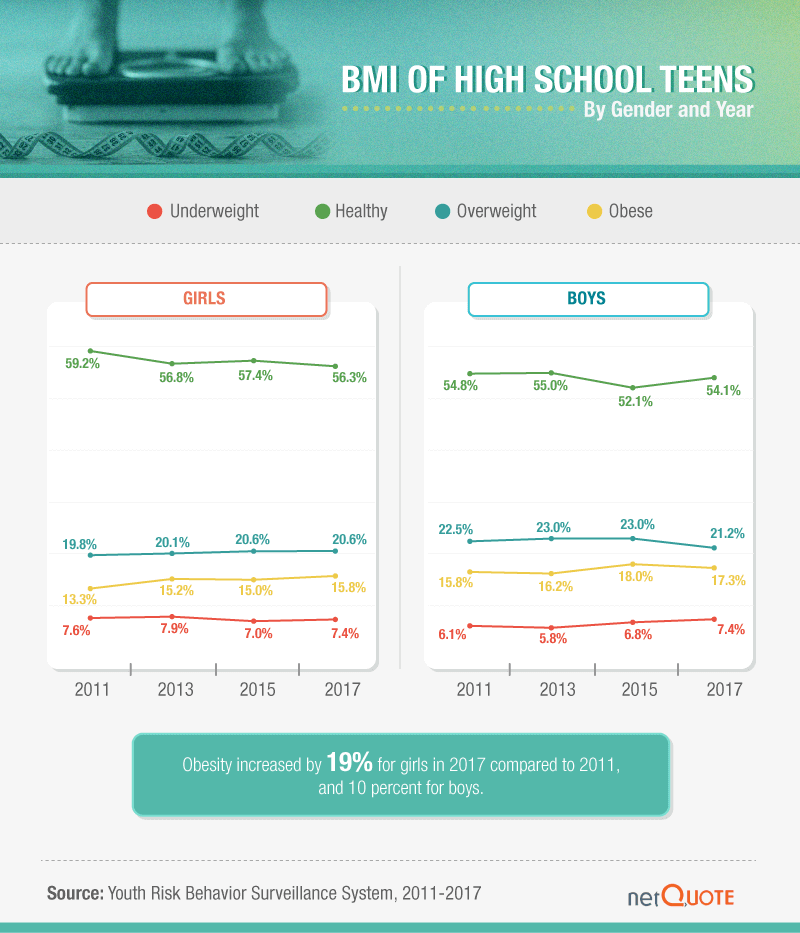
According to the Centers for Disease Control and Prevention (CDC), an overweight or obese teen is defined as a student whose body mass index (BMI) is in the 85th percentile or greater. While BMI is calculated by dividing a person’s overall weight by their height, obesity is often also described as being 10 percent or more outside of the ideal body weight.
Since 2011, there’s been around a 10 percent increase in obesity among boys and a 19 percent increase in obesity among girls in high school. According to the YRBSS, only 56 percent of teenage girls and 54 percent of teenage boys qualified as having a healthy weight in 2017. While roughly 7 percent of the remaining teens were classified as being underweight (which poses an entirely different set of health concerns), more than 1 in 3 boys and girls were identified as being either overweight or obese in 2017. In both cases, boys had a higher rate of obesity (over 17 percent) and being overweight (21 percent).
Defining a Healthy Weight
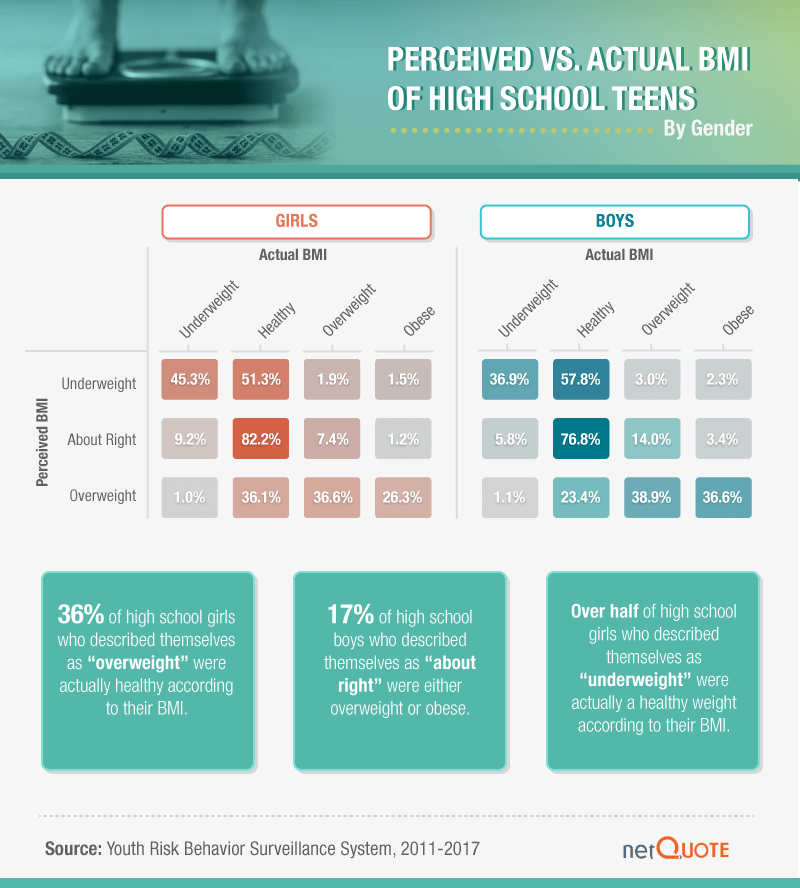
With a rising percentage of teenagers falling outside of a healthy BMI or body weight, it can be difficult for some students to recognize when their body shape or size has started to become a potential health hazard. Because eyeballing the difference between their ideal weight and their actual size can be ineffective, teens need additional resources to understand where they fall between being underweight and potentially obese.
The scale alone isn’t enough, and while teens could use an online body mass index calculator (with the correct measurements), we found some people simply didn’t understand the difference between healthy and not.
Only 82 percent of teenage girls and about 77 percent of teenage boys who estimated their weight was about right in terms of their height and overall wellness actually qualified as healthy. Instead, nearly 1 in 10 girls who felt their weight was appropriate were actually underweight, and more than 17 percent of boys who felt the same were either overweight or obese.
Teens who thought their weight was appropriate weren’t the only ones who were mistaken though. More than half of girls who self-identified as underweight were actually healthy, and over 1 in 3 teenage girls and nearly 1 in 4 teenage boys who considered themselves overweight were, in reality, a healthy weight.
Making a Change
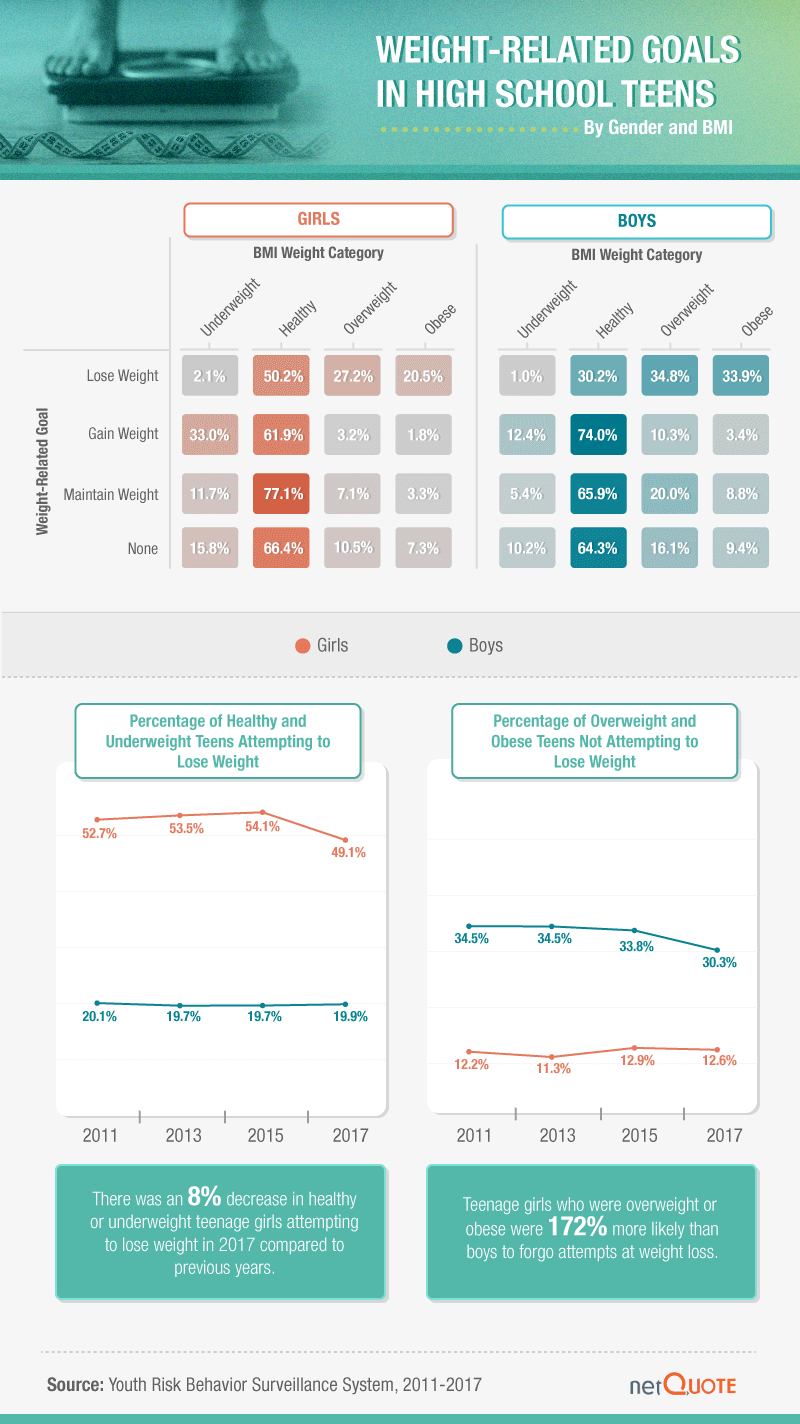
There are a number of reasons childhood and teenage obesity can occur, and they aren’t always directly linked to a specific habit or behavior. In some adolescents, obesity is a genetic or biological disposition. For other teens, the cause can be environmental or cultural instead. It can be so environmental and culturally-related, in fact, that there are taxes against sugary sodas and government-sponsored programs to encourage exercise, aimed at establishing healthier habits and re-educating families on nutrition.
Encouragingly, most teens have at least some idea of what they need to do to correct their body size for the better. Roughly 27 percent of teenage girls classifying as overweight and 21 percent of teenage girls classifying as obese believed they needed to lose weight to find a healthy balance. As we found, around 34 percent of teenage boys in similar situations had the same idea.
Unfortunately, unrealistic body standards could be encouraging dangerous behaviors in teens looking to achieve a certain size or weight. Nearly 50 percent of teenage girls with a healthy BMI and 2 percent who were already underweight believed they needed to lose more weight to be healthy.
Addressing Their Weight Concerns

Whether they’re genuinely addressing an unhealthy BMI or struggling to achieve a specific look or size for other reasons, a vast majority of teen girls between the ages of 13 and 18 are actively trying to lose weight. Over 60 percent of girls aged 14 and older reported that they intended to lose weight.
Our earlier chart also revealed that over a third of girls who described themselves as overweight were actually healthy according to their BMI, and another 1 percent of girls who felt overweight were actually underweight. The conversation of weight loss can be a sensitive and potentially harmful one, based on the intent. Parents should be cognizant of how they approach weight-based conversations with their children and should help make teens active participants in their health journey, be it by achieving a healthier weight or simply creating health-conscious habits.
Targeted Intimidation
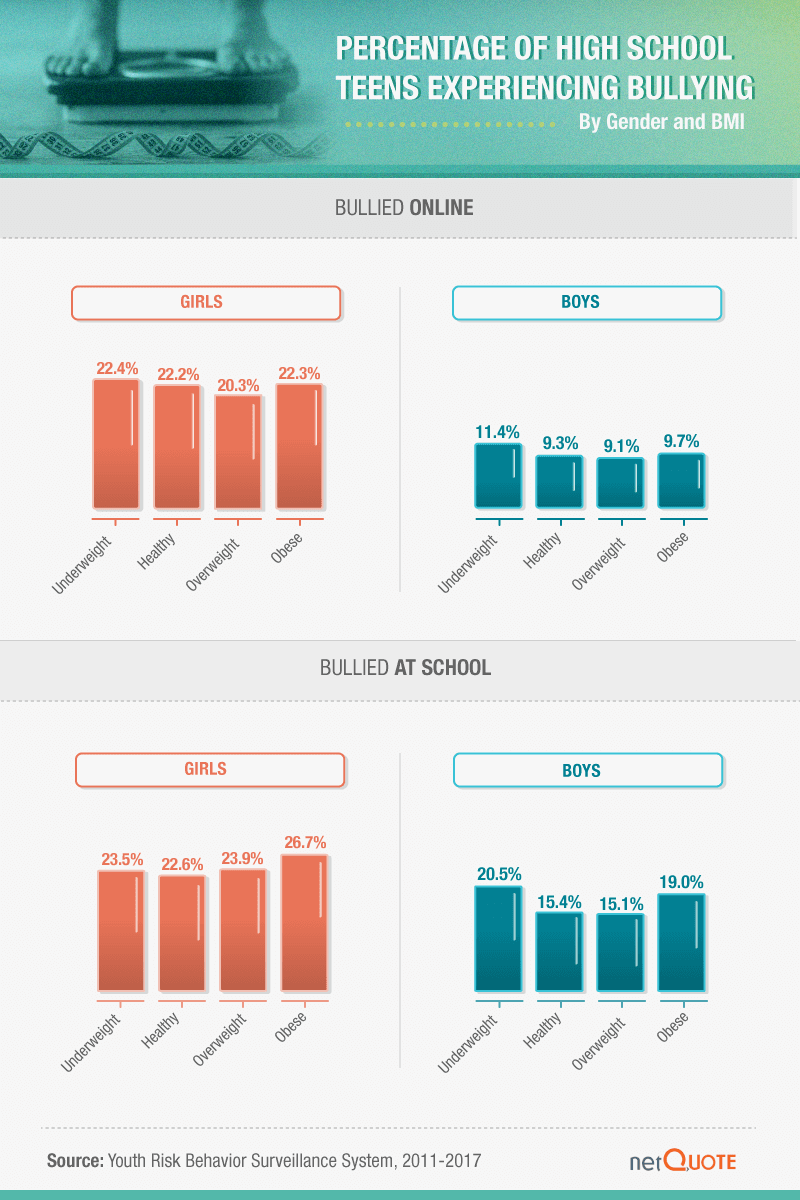
Sometimes, one of the hardest parts of helping overweight or obese teens manage their body size isn’t just how they see themselves but how other students may react to their weight. For school-aged children, cyberbullying and harassment are very serious issues. And while students may feel targeted because of their creative spirit, sexuality, or even success at a particular activity or subject, their physical features may also have the ability to attract attention among bullies.
Regardless of their weight or size, more than 1 in 5 teenage girls experienced digital or face-to-face bullying while in high school. Still, among teenage girls, cyberbullying and harassment at school were much more common among obese children than those who were underweight. Among teenage boys, we found bullying was most common for those who were underweight instead.
Emotional Distress
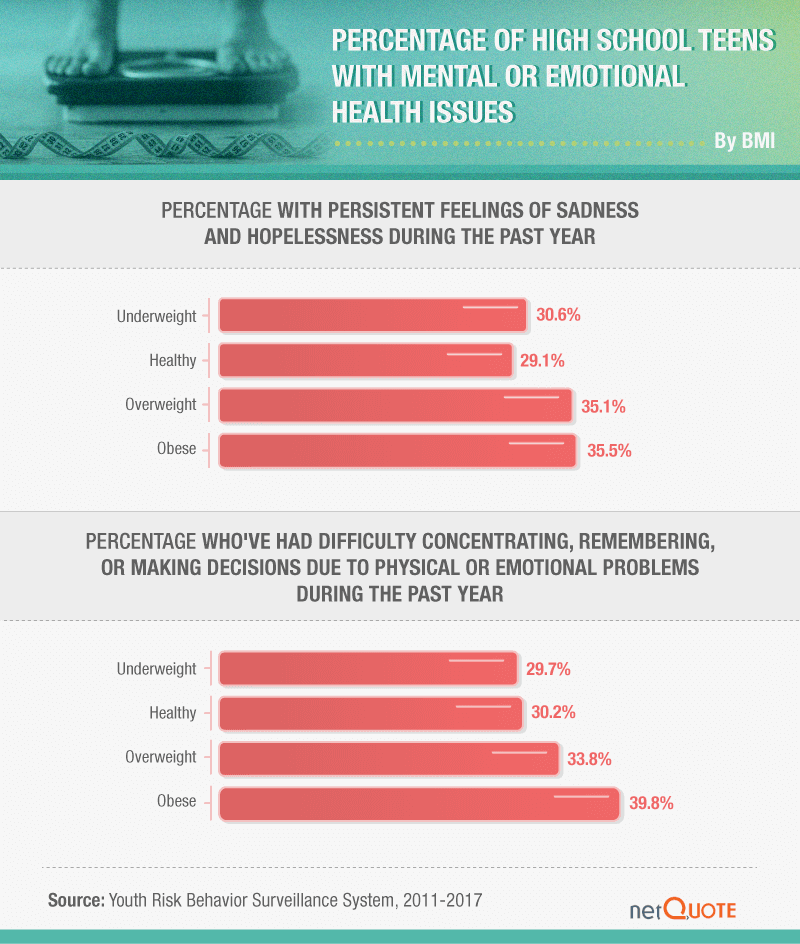
In many ways, children whose weight falls outside the healthy parameters (both under and overweight) experience a kind of social stigma at school regarding their appearance. On the surface, this may manifest as a form of cyberbullying or harassment at school, but on a deeper level, children who experience weight control issues may also be more likely to develop mental health concerns including depression and emotional eating.
Overwhelmingly, teenagers who were either overweight or obese were more likely to admit feeling sad or hopeless every day for long stretches of time to the point that their daily routines suffered as a result. Compared to 29 percent of healthy teens and 30 percent of underweight teens, more than 35 percent of overweight and obese high school-aged children experienced this level of emotional trauma.
That emotional duress doesn’t just impact students internally, either. When asked about their level of concentration, nearly 40 percent of obese teens believed they had trouble remembering things or making decisions as a result of a physical, mental, or emotional problem. Less than 34 percent of overweight teens and 30 percent of healthy or underweight students said the same.
Finding a Healhty Balance
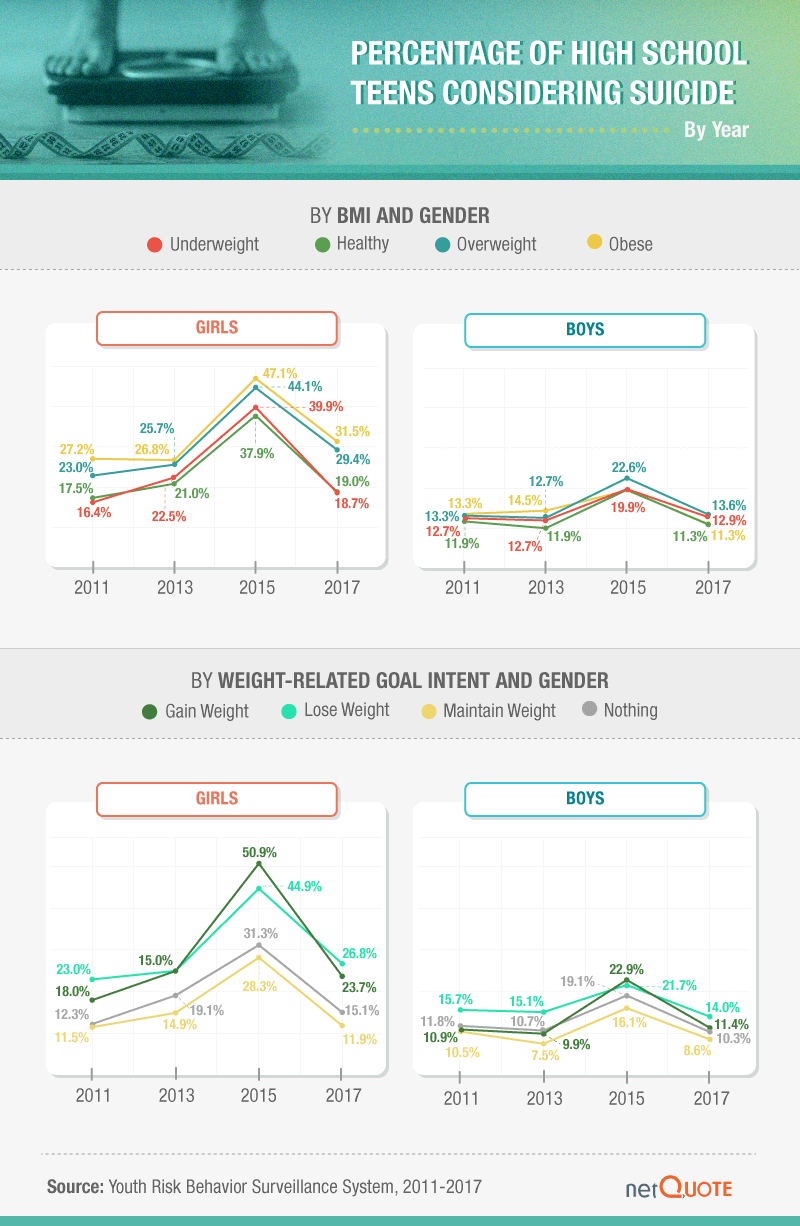
According to the CDC, children with obesity can suffer from long-term social and emotional consequences. According to our research, teenage girls who were obese expressed thoughts of suicide more so than their overweight and underweight peers. The spike in thoughts of suicide in 2015 reflect a phenomenon researchers are reporting as the highest surge in suicide in nearly 30 years, affecting women most acutely, and significantly, girls ages 10 to 14 years old. In both girls and boys, those in the healthy BMI category considered suicide the least for most years.
The consequences of being obese include numerous health conditions such as asthma and sleep problems. Socially, children who are obese are more likely to be bullied. It’s easy to see how these health issues could exacerbate or create mental health issues that may lead to suicidal thoughts.
Talking About Health With Teens
For teens and young adults, the concern over weight is a sensitive conversation that may undoubtedly stem from societal norms and pressures in terms of body image. However, when discussed in the realm of health, both physical and emotional, it can be a meaningful discussion to have regardless of where teens may fall on the BMI spectrum. In the same way that being overweight can have a negative impact on their mental health and social experience at school, there are serious physical consequences to consider as well, for those overweight and underweight alike. Children who are obese are also far more likely to remain obese well into adulthood, which can significantly lower their life expectancy.
Helping your kids stay healthy may feel difficult from time to time, but at netQuote, we want to help make getting the care you need as stress-free as possible. By helping you compare policies and save money on the coverage you need for everything from your family’s health to your home and automobiles, netQuote is committed to helping you find the best rates for whatever your needs may be. To learn more or to start saving now, visit us online at netQuote.com today.
Methodology
We collected survey data from the Centers for Disease Control and Prevention’s Youth Risk Behavior Surveillance System from 2011-2017. We analyzed teen BMI and self-described weight as well as weight-loss intent to determine “risk groups” of youth who were healthy and trying to lose weight or those who were overweight or obese and not trying to lose weight. The survey includes responses from over 14,000 students per year. We excluded responses of those who were 13 years or younger in assets regarding age, due to sample size issues. No statistical testing was used to produce this content.
Sources
- https://www.verywellfamily.com/is-my-toddler-obese-4083054
- https://www.cdc.gov/healthyschools/obesity/facts.htm
- https://www.mayoclinic.org/diseases-conditions/childhood-obesity/symptoms-causes/syc-20354827
- https://www.cdc.gov/obesity/childhood/defining.html
- https://www.aacap.org/AACAP/Families_and_Youth/Facts_for_Families/FFF-Guide/Obesity-In-Children-And-Teens-079.aspx
- https://www.healthline.com/health/underweight-health-risks
- https://teens.webmd.com/just-for-teens-are-you-overweight#1
- https://www.girlsempowermentnetwork.org/blog/media-today-unattainable-beauty-standards/
- https://www.webmd.com/parenting/raising-fit-kids/weight/treatment-overweight-teen#2
- https://www.cbsnews.com/news/what-not-to-say-to-help-your-teen-lose-weight/
- https://www.huffingtonpost.com/entry/how-big-of-a-problem-is-cyber-bullying-among-teens_us_58c4a397e4b0a797c1d39da3
- https://www.verywellfamily.com/reasons-why-kids-are-bullied-460777
- https://www.healthychildren.org/English/health-issues/conditions/obesity/Pages/The-Emotional-Toll-of-Obesity.aspx
- https://www.cdc.gov/obesity/childhood/causes.html
Fair Use Statement
Want to help us share these facts and findings regarding teenage obesity? Feel free to repost any of the results of this study on your own site for any noncommercial use. We only ask that you include a link back to this page so our contributors get credit for their work too.
